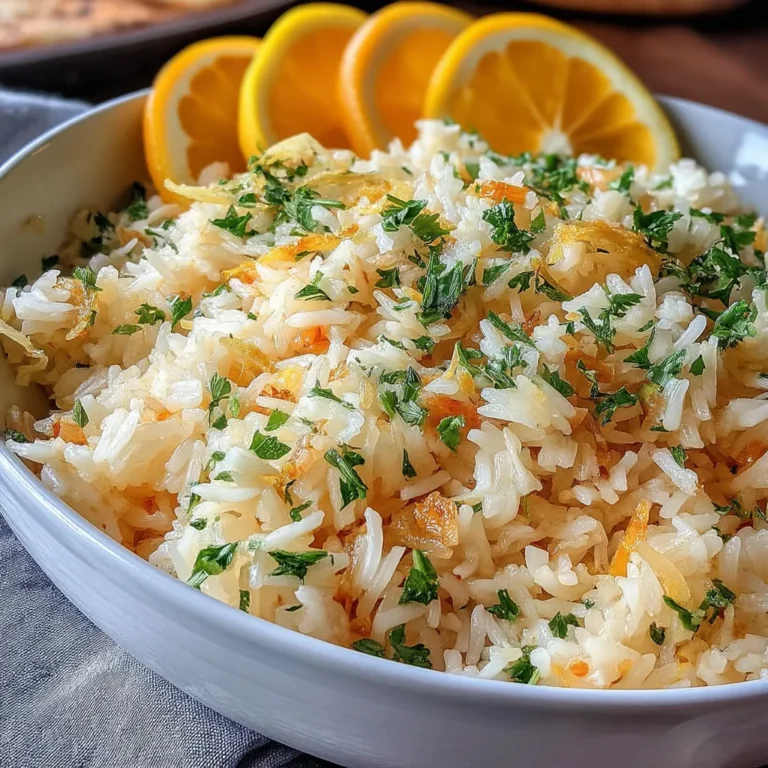Introduction
Zesty Lemon Herb Rice Pilaf is a vibrant and flavorful side dish that elevates any meal. With its fresh ingredients and bright flavors, this recipe is not only easy to prepare but also a delightful addition to your dining table. Whether you’re serving it alongside grilled meats or as part of a vegetarian feast, this pilaf brings a refreshing twist to traditional rice dishes.
Rice pilaf has a rich history in various cuisines around the world, known for its adaptability and versatility. It can be customized to suit different tastes and occasions, making it a staple in many households. This particular version showcases the perfect balance of citrus and herbs, creating a dish that is both fragrant and satisfying.
Recipe Overview
– Total Time: 30 minutes
– Servings: 4
– Difficulty: Easy
Ingredients
– 1 cup long-grain white rice
– 2 tablespoons olive oil
– 1 tablespoon butter
– 1 small onion, finely chopped
– 2 cloves garlic, minced
– 2 cups vegetable or chicken broth
– 1 teaspoon lemon zest
– 2 tablespoons lemon juice
– 2 tablespoons fresh parsley, chopped
– 1 tablespoon fresh thyme, chopped
– 1 teaspoon dried oregano
– Salt and pepper to taste

Instructions
1. Rinse the rice under cold water until the water runs clear, then drain.
2. In a medium saucepan, heat the olive oil and butter over medium heat.
3. Add the chopped onion and sauté until translucent, about 3-4 minutes.
4. Stir in the minced garlic and cook for an additional minute until fragrant.
5. Add the rinsed rice to the saucepan and stir to coat the grains with the oil and aromatics.
6. Pour in the broth and bring to a boil.
7. Once boiling, reduce the heat to low, cover, and let simmer for 15-18 minutes or until the rice is tender and the liquid is absorbed.
8. Remove from heat and let it sit covered for 5 minutes.
9. Fluff the rice with a fork, then stir in the lemon zest, lemon juice, parsley, thyme, oregano, and season with salt and pepper to taste.
Understanding the Basics of Rice Pilaf
What is Rice Pilaf?
Rice pilaf is a cooking method that involves sautéing rice in fat before adding liquid, resulting in fluffy, separated grains. This technique enhances the rice’s flavor and texture, making it a popular choice in many cultures.
Role of Aromatics
Aromatics, such as onions and garlic, are essential in rice pilaf. They build a strong flavor foundation, enriching the dish and making each bite more enjoyable.
Types of Rice for Pilaf
Long-grain white rice is commonly used for pilaf due to its ability to remain separate and fluffy when cooked. Other varieties, like basmati or jasmine, can also be excellent choices, each bringing its unique flavor and aroma.
Key Ingredients and Their Benefits
Long-Grain White Rice
Long-grain white rice is ideal for pilaf as it cooks evenly and maintains a light texture. Rinsing before cooking removes excess starch, preventing clumping.
Aromatics
Onion and garlic are key components that enhance the flavor of the pilaf. They provide depth and complexity, making the dish more flavorful.
Broth Selection
Choosing between vegetable or chicken broth can significantly impact the flavor of your pilaf. Vegetable broth offers a lighter taste, while chicken broth adds a richer, savory note.
Fresh Herbs and Citrus
Lemon zest and juice, along with fresh herbs like parsley, thyme, and oregano, brighten the dish, adding freshness and vibrancy that complements the rice beautifully.
Olive Oil and Butter
Combining olive oil and butter not only adds richness but also enhances the overall flavor profile of the pilaf, making it more satisfying.

Tips for Perfecting Zesty Lemon Herb Rice Pilaf
Preparing the Aromatics
Sautéing aromatics is a crucial step in enhancing the flavor profile of your Zesty Lemon Herb Rice Pilaf. Start by heating a tablespoon of olive oil or butter in a medium saucepan over medium heat. Add finely chopped onions and minced garlic, allowing them to soften and release their natural sweetness. This process creates a flavorful base that will infuse the rice as it cooks. Ensure you stir frequently to prevent burning, which can create a bitter taste.
Toasting the Rice
Toasting the rice before adding any liquid is an essential technique that enhances both taste and texture. Add the rinsed rice to the saucepan with the sautéed aromatics and stir continuously for about 2-3 minutes. This step allows the rice to absorb the flavors of the oil and aromatics, while also creating a slightly nutty flavor that elevates the entire dish. The grains will turn a light golden color, indicating they are ready for the next step.
Adding Liquid and Seasoning
Once the rice is toasted, it’s time to add the liquid. For this pilaf, use a combination of vegetable or chicken broth for depth of flavor, along with freshly squeezed lemon juice to provide that zesty kick. Be sure to season the mixture with salt, pepper, and your choice of herbs—such as parsley or thyme—before bringing it to a boil. The right balance of liquid and seasoning is vital for infusing the rice with flavor and achieving the desired texture.
Simmering Technique
After bringing your mixture to a boil, reduce the heat to low and cover the saucepan with a tight-fitting lid. Allow the rice to simmer gently for about 15-20 minutes, or until all the liquid is absorbed. Avoid lifting the lid during cooking, as this can disrupt the steaming process essential for perfectly fluffy rice. Checking for doneness by tasting a grain will ensure you achieve the ideal texture—light and airy.
Final Touches
Once the rice is cooked, remove it from the heat and let it rest for 5-10 minutes, still covered. This resting period allows the steam to continue cooking the rice gently and helps to firm up the grains, preventing them from becoming mushy. Fluff the pilaf with a fork before serving, incorporating additional herbs or a splash of lemon juice for an extra burst of flavor.
Serving Suggestions
Ideal Pairings
Zesty Lemon Herb Rice Pilaf is a versatile side dish that pairs beautifully with a variety of main courses. Serve it alongside grilled chicken or fish, such as salmon or tilapia, to complement the zesty flavors. It also works well with roasted vegetables or a fresh salad, making it an excellent choice for vegetarian meals. The lightness of the pilaf balances heavier dishes and adds a refreshing touch.
Presentation Tips
To enhance the visual appeal of your dish, consider garnishing the pilaf with lemon wedges and a sprinkle of fresh chopped herbs, such as parsley or dill. This not only adds a pop of color but also invites guests to enjoy the fresh flavors. Serving the pilaf in a decorative bowl can also elevate the presentation, making it suitable for both casual family dinners and more formal occasions.
Nutritional Information
Each serving of Zesty Lemon Herb Rice Pilaf contains approximately 200 calories, providing a healthy dose of carbohydrates while remaining low in fat. The use of whole grain rice offers dietary fiber, which is beneficial for digestive health. Additionally, fresh herbs contribute essential vitamins and antioxidants, making this dish not just delicious but also nutritious.
Conclusion
In summary, Zesty Lemon Herb Rice Pilaf is a delightful dish that combines vibrant flavors with ease of preparation. Its versatility makes it a perfect accompaniment for any meal, whether a simple weeknight dinner or a festive gathering. Encourage creativity in the kitchen by experimenting with different herbs and spices, making this recipe your own. Try the pilaf as a refreshing side, and enjoy the burst of flavor it brings to your table!

Zesty Lemon Herb Rice Pilaf
Ingredients
- 1.0 cup long-grain white rice
- 2.0 cups vegetable or chicken broth
- 1.0 medium onion, finely chopped
- 2.0 cloves garlic, minced
- 1.0 tablespoon olive oil
- 1.0 tablespoon unsalted butter
- 1.0 zest lemon
- 2.0 tablespoons fresh lemon juice
- 1.0 teaspoon dried thyme
- 1.0 teaspoon dried oregano
- 0.5 cup fresh parsley, chopped
- 0.0 to taste salt and pepper
Instructions
- Prepare the Aromatics: In a medium saucepan, heat the olive oil and butter over medium heat. Add the chopped onion and sauté for 3-4 minutes until it becomes translucent. Stir in the minced garlic and cook for an additional minute until fragrant.
- Toast the Rice: Add the long-grain rice to the saucepan and stir well to coat the rice with the oil and flavors. Continue to sauté for about 2-3 minutes until the rice begins to turn slightly golden.
- Add the Liquid: Pour in the vegetable or chicken broth, lemon zest, and lemon juice. Sprinkle in the dried thyme, oregano, salt, and pepper to taste. Bring the mixture to a boil.
- Simmer the Pilaf: Once boiling, reduce the heat to low, cover the saucepan with a lid, and let it simmer for 15-18 minutes, or until the rice is tender and has absorbed the liquid.
- Finishing Touches: Remove the saucepan from heat and allow it to sit, covered, for 5 minutes. This helps the rice to fluff up. After resting, stir in the fresh parsley and adjust seasoning with extra salt and pepper if necessary.
- Serve: Fluff the rice with a fork and serve warm, garnished with additional parsley and lemon wedges if desired.
